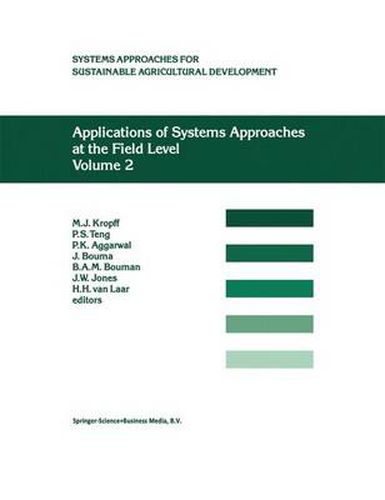Readings Newsletter
Become a Readings Member to make your shopping experience even easier.
Sign in or sign up for free!
You’re not far away from qualifying for FREE standard shipping within Australia
You’ve qualified for FREE standard shipping within Australia
The cart is loading…






This title is printed to order. This book may have been self-published. If so, we cannot guarantee the quality of the content. In the main most books will have gone through the editing process however some may not. We therefore suggest that you be aware of this before ordering this book. If in doubt check either the author or publisher’s details as we are unable to accept any returns unless they are faulty. Please contact us if you have any questions.
Systems approaches for agricultural development are needed to determine rational strategies for the role of agriculture in national development. Mathematical models and computer simulation provide objective tools for applying science to determine and evaluate options for resource management at field, farm and regional scales. However, these tools would not be fully utilizable without incorporating social and economic dimensions into their application. The second international symposium, Systems Approaches for Agricultural Development (SAAD), held in Los Banos, 6-8 December 1995, fostered this link between the biophysical sciences and the social sciences in the selection of keynote papers and oral presentations, a selection of which are included in this volume. The contents further reflect how systems approaches have definitely moved beyond the research mode into the application mode. The large number and high quality of interdisciplinary research projects reported from different parts of the globe, to determine land use options that will meet multiple goals and yet sustain natural resource bases, is a key indicator of this “coming of age’. At the farm level, where trade-off decisions between processes and products (commodities) feature strongly, much progress is also evident in the development of systems-based tools for decision making. At the field level optimization of resource use and minimizing environmental effects has become of major concern for which systems approaches are indispensable.
$9.00 standard shipping within Australia
FREE standard shipping within Australia for orders over $100.00
Express & International shipping calculated at checkout
This title is printed to order. This book may have been self-published. If so, we cannot guarantee the quality of the content. In the main most books will have gone through the editing process however some may not. We therefore suggest that you be aware of this before ordering this book. If in doubt check either the author or publisher’s details as we are unable to accept any returns unless they are faulty. Please contact us if you have any questions.
Systems approaches for agricultural development are needed to determine rational strategies for the role of agriculture in national development. Mathematical models and computer simulation provide objective tools for applying science to determine and evaluate options for resource management at field, farm and regional scales. However, these tools would not be fully utilizable without incorporating social and economic dimensions into their application. The second international symposium, Systems Approaches for Agricultural Development (SAAD), held in Los Banos, 6-8 December 1995, fostered this link between the biophysical sciences and the social sciences in the selection of keynote papers and oral presentations, a selection of which are included in this volume. The contents further reflect how systems approaches have definitely moved beyond the research mode into the application mode. The large number and high quality of interdisciplinary research projects reported from different parts of the globe, to determine land use options that will meet multiple goals and yet sustain natural resource bases, is a key indicator of this “coming of age’. At the farm level, where trade-off decisions between processes and products (commodities) feature strongly, much progress is also evident in the development of systems-based tools for decision making. At the field level optimization of resource use and minimizing environmental effects has become of major concern for which systems approaches are indispensable.